https://www.youtube.com/watch?v=Wt4y1-F-JKc
How to Make Fresh EGG PASTA DOUGH from Scratch
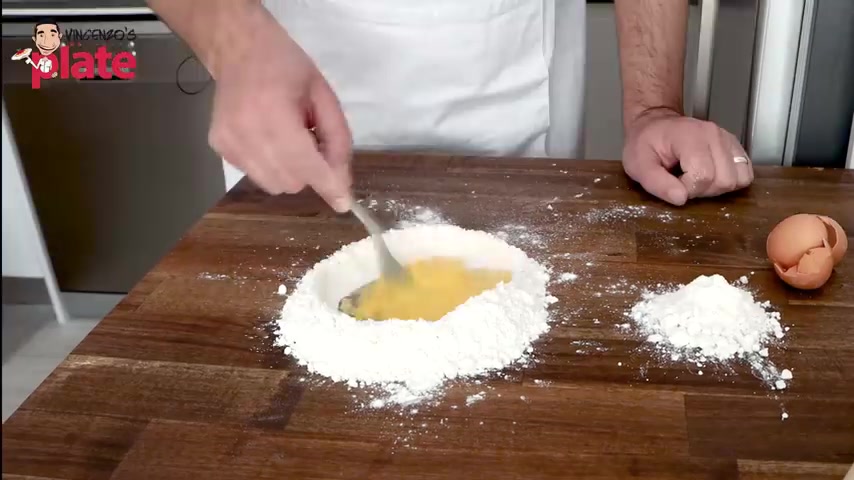
This video is for you who want to learn how to make pasta fresh pasta .
If you want to become a master of pasta making , this is the video for you .
We start from the history all the way to how to make the perfect dough for your pasta .
Stay tuned because you're about to become a pasta master .
Hi and welcome to Vince's plate .
Today .
We are becoming pasta masters and I wanna tell you a little story about egg pasta pasta in general .
Now it's very interesting and please listen , if you're not interested , just go forward and go straight to the recipe .
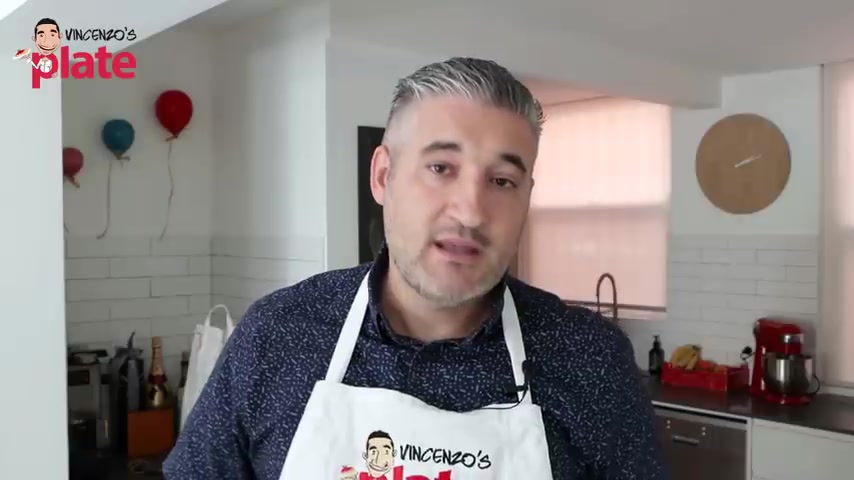
So pasta was created before Marco Polo went to China .
Historians says that Romans and Greeks already had the lasagna pasta shade .
Then the real pasta was created in Sicily when the Arabs invaded Sicily .
And for a short time when the Arabs were there , this pasta was created , it was semolina and water because the regions of Sicily , they have lots of selina .
And basically this pasta was created and different shapes were created .
So the pasta started to travel , it was traveling all over Italy .
So from Sicily all the way to North many different shapes were created .
And it's fascinating how , but when it got to north , the north was , was rich and still is richer than the south .
The north and the eggs , the south was poor .
Eggs were not popular , were not available to everyone .
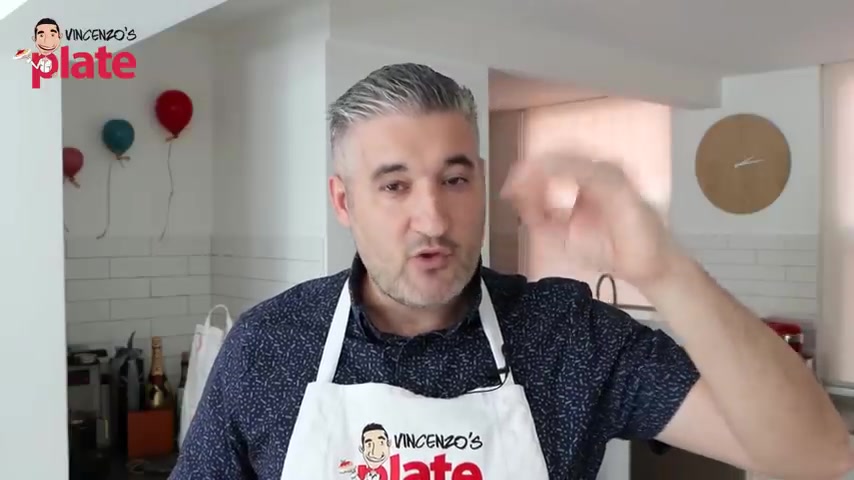
So the northern Italians decided to use eggs .
And also in the north , the they have a soft flour with lots of proteins and then they were created tortellini and more and more and more .
So if you think about ravioli , they always come from the north because the north was richer and they had the ingredients to fill the pasta in the south where it was more then dry pasta was very popular .
Like in Naples , spaghetti were created in Naples uh or they all pasta made with and water , you put them together cheap ingredients and you can feed the whole family .
OK .
So rarely or not at all , you go to Sicily family is famous for making tortellini or ravioli or a filled pasta in the Southern Italy field .
Pasta is not very popular .
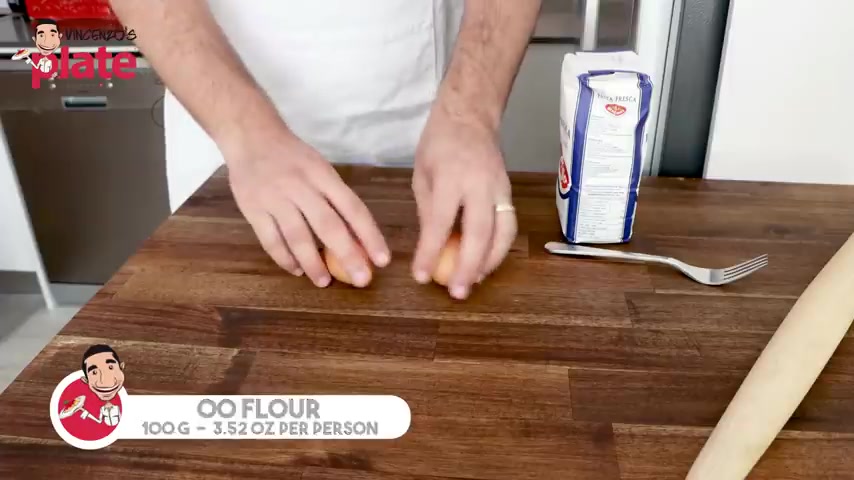
Of course , now people eat it but historically is not popular .
I think it's nice to know this .
Now that you know the the the history of fresh pasta .
Let's go and make fresh pasta and let's learn step by step how to make this beautiful , luxurious , privileged pasta .
This is how easy and simple it is to make pasta , but you need to do it right now .
There are two ingredients to make fresh egg pasta .
You need the eggs and you need the flour .
You need a good quality flour .
Now ingredients , how do you measure one egg is 100 g of flour .
So if you have two eggs , you need 200 g of flour .
See us Italians .
We love to eat pasta , we love it .
So we do eat a lot .
Ok ?
For you .
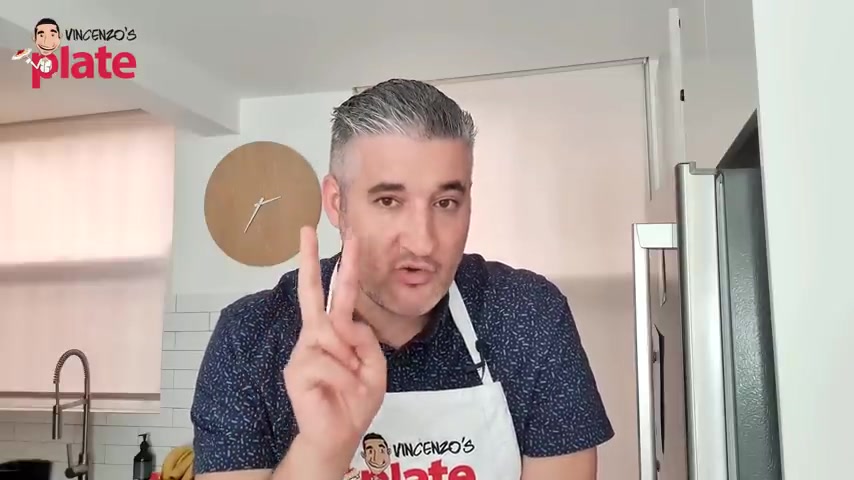
I will say that with two eggs and 200 g of flour , you should be able to easily make pasta for 4 to 6 people .
But it depends where you are .
This is totally up to you .
So when you make pasta , you always want to have flour next to you .
Flour is kind of your best friend .
Um So I've got a little bit there and then what do we do is we need to measure , we need to get 200 g because I'm using two eggs .
If you don't have a , a scale , what do you do ?
This is what I do .
I just get a full hand of flour and that should be about 100 g .
Say I do one full hand of flour .
That's about 200 g .
So see that's , it's about 200 g and then I've got a little bit on the side just in case I need it .
Now , the first thing you do is with this is you create a well like this .
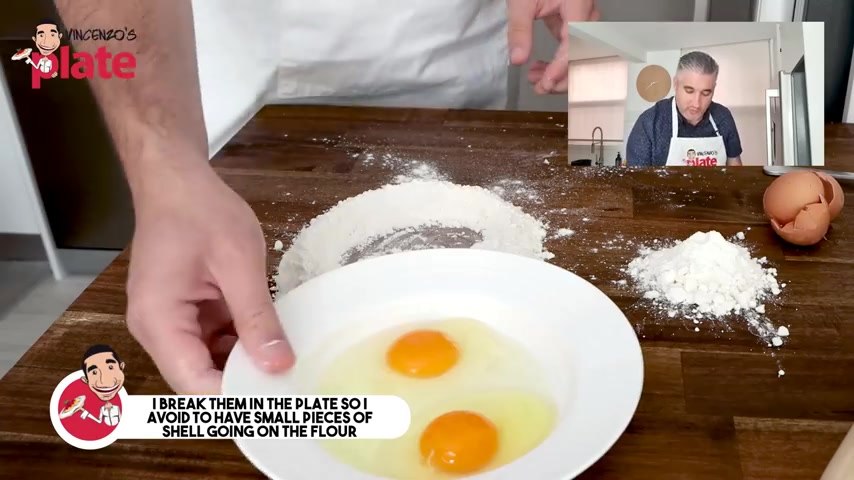
And the reason why we do the well is because we don't want the eggs to go out and the eggs , it's important that your eggs are at room temperature .
What I like to do with the eggs is I like to break the eggs in a plate and we're going to put the eggs in the inside just like that .
So you need organic , top quality eggs and you also need top quality flour in order to get a nice yellow pasta .
Ok ?
Now what we do , we break a little bit by using a fork .
We mix it as I'm doing this , I'm trying to get collect a little bit of flour from the sides from the edges .
So it helps me to make it creamier .
So take your time and this is something you must do by hand .
This is kind of a must do with your hand .
Now I'm gonna add a little bit of flour from the sides .
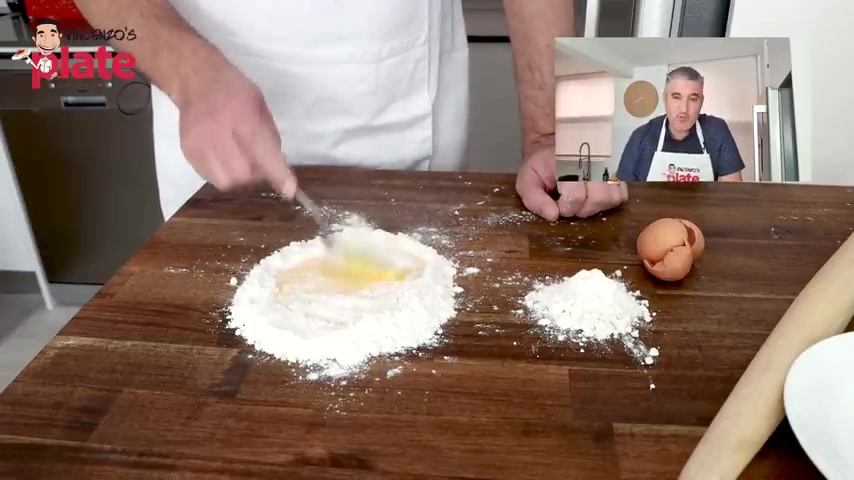
Now , when you make pasta , I recommend you to use a wooden board just because the texture of the pasta will be nicer and a bit more rustic .
You can use any other bench top that you want .
But the wooden top for me is the best one .
Now , I'm gonna finish this off with , you know what's left here of the flour because I don't want this to be runny .
But as you can see , takes no time now to become creamy and slowly , soon , very soon we're gonna start needing the dough .
Now , needing the dough .
It's something that I like to do with , you know , with my hands .
I wanna feel the dough because it's all about feeling it .
I use , make sure that I don't waste anything .
And I start , I start mixing , I start mixing this dough just like this just with one hand .
I keep one hand free .
So now you need to fill it with your hands really slowly and you need to try and keep the same movement .
Now , how do we keep the same movement ?
OK .
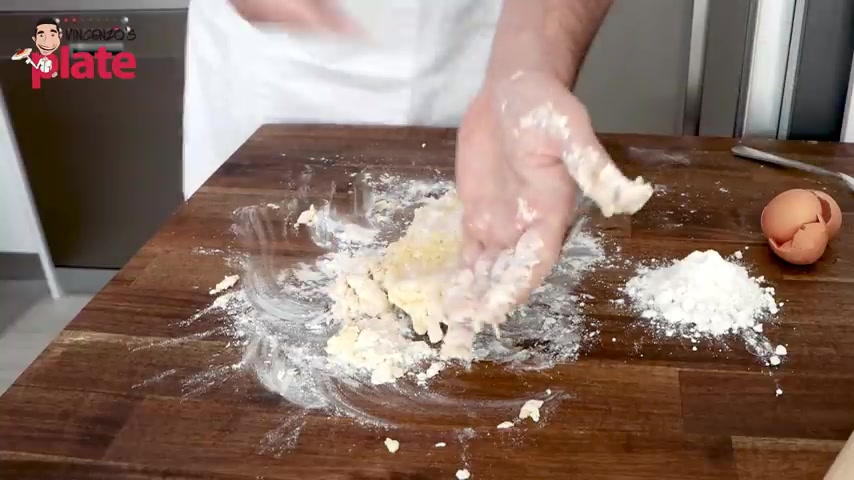
Well , you keep us in a moment by do this .
I like to do this .
So I press forward with this part of my hand .
Then I fall back , then I press forward again , then I fall back , then I press forward forward again , then I fall back and then I turn it around like this .
Now this is a very good friend of yours .
Make sure you use this or you can use a knife because this will clean your board and it will get any excess flour that you have there .
Now that the dough , it's a less sticky .
What I do is I put flour on my hand .
So what we do now we use two hands again , push forward , back , push forward and back again .
That's my technique .
That's how I like to do it .
You wanna do a different way .
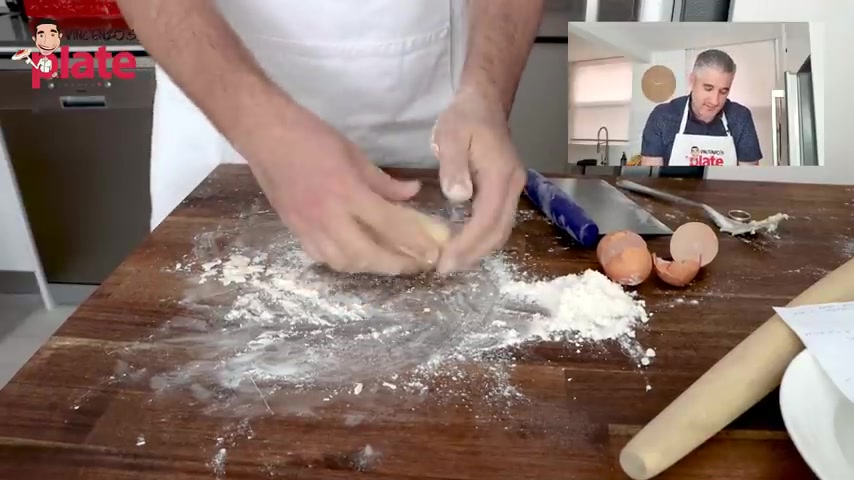
Well , you can do like this , you can do stretch 12 fold , 12 fold .
This is really , this is really personal and you guys have to do what you want .
OK .
Why I said to you don't use the um stem mixer .
Well , if you use the stem mixer , the dough will stress or the protein will stress and go crazy everywhere and the dough will kind of become a little bit rubbery .
So this process takes about 10 minutes to be done .
How do you know when it's finished ?
How do you know when you are done ?
Well , you do know when you're done when you don't see any flour left on the dough .
And as you can see the dough , it's almost ready .
And by touching the dough , you can see , can you see how the whale is reacting is nice and soft .
It's a beautiful color .
It's a very nice color .
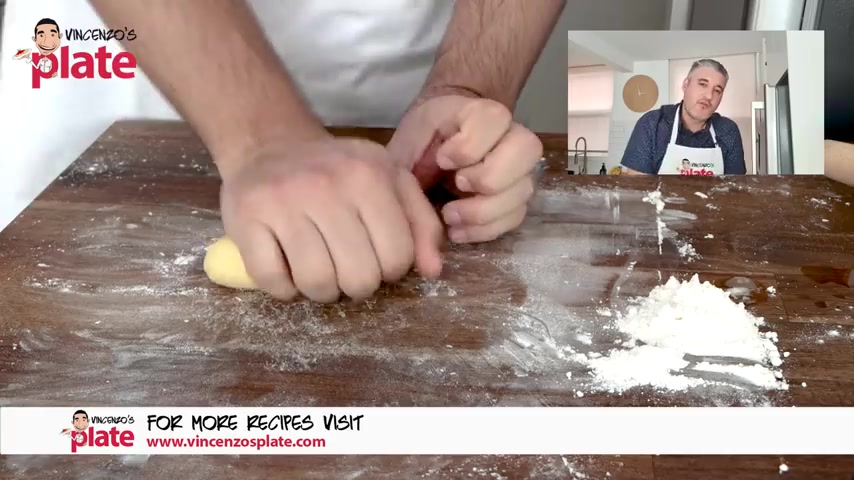
If you are walking the door , you find the door , not too soft , like it's not dry , but it's not too soft , just the way you want it .
What you can do is you can , um , just let it rest for about 10 minutes and you will see that the dough will be much , much , much softer and then you can keep going and need it dough .
There are cases where your dough it's a bit dry when you make it .
So what you do just wet your hands in the sink , have your heads wet , wet and the dough will absorb the water from your hands and it will , uh , it will be much easier to work the dough .
Ok .
Now , we just need to rest it for about 20 minutes and then we wait to work it .
Ok .
And today I'm going to make the pasta with rolling pain .
Ok .
I'll show you how to use the pasta machine as well .
But I'll show you the real way the rolling pain the best way for me to make pasta because again , we are not stressing it .
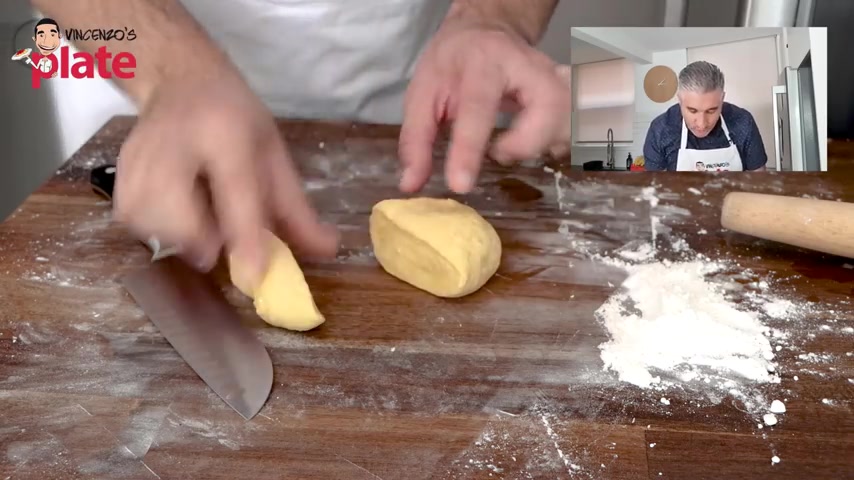
The pasta would be more relaxed and not rubbery when you make it with the rolling pain .
After 20 minutes , let's see what happened .
And see we have a beautiful dough and then what we do is we start cutting .
I say about this much .
Look at that and look at the inside , look what you want .
This is the reaction that you want inside your pasta .
And now what I do with this part , I don't want this to dry up .
So we always cover this , always cover and this is the part we're gonna use .
You need to remember the flour .
It's your best friend at this time .
Ok ?
So this part it is a bit sticky .
So you need to put the flour on top and you need to put the flour at the bottom .
OK ?
So we never want the pasta to be sticky .
You don't want the pasta to get stuck to the rolling pain .
So you put flour around the rolling pain .
And now we can start .
Ok .
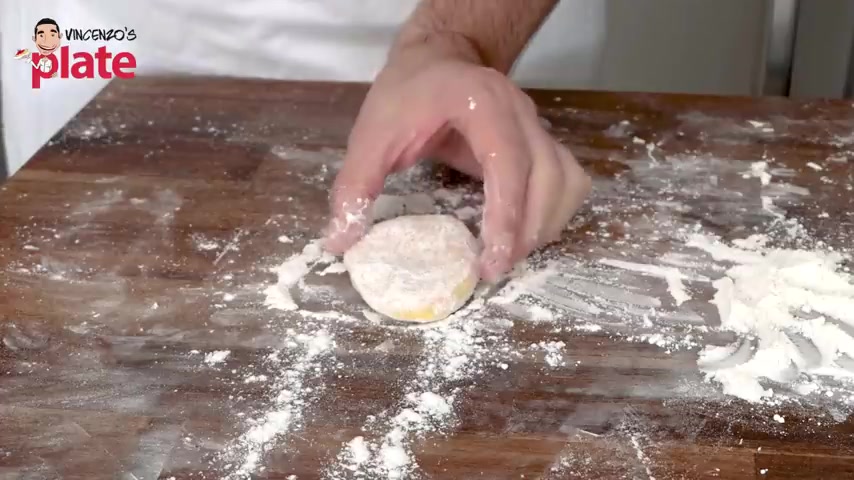
Now , as you can see here , I'm not going for the long pasta , I'm going for this side because it is wide so we can make it long and wide .
So I got one and then I got back , see how much I stretched it and I turn it around and I do it again .
One and then I go back from the middle towards me too .
Now that it's stretched , I can just do this 12 , 12 .
So we try to have it same .
Now it's round .
If you don't have a rolling pain , don't worry , you can use a bottle of wine .
Now , what I like to do here , I push forward and I hold with my hand over the day .
Now , this the dough is getting bigger .
We can use this technique , but before you need to use the other technique , now it depends what pasta you are making .
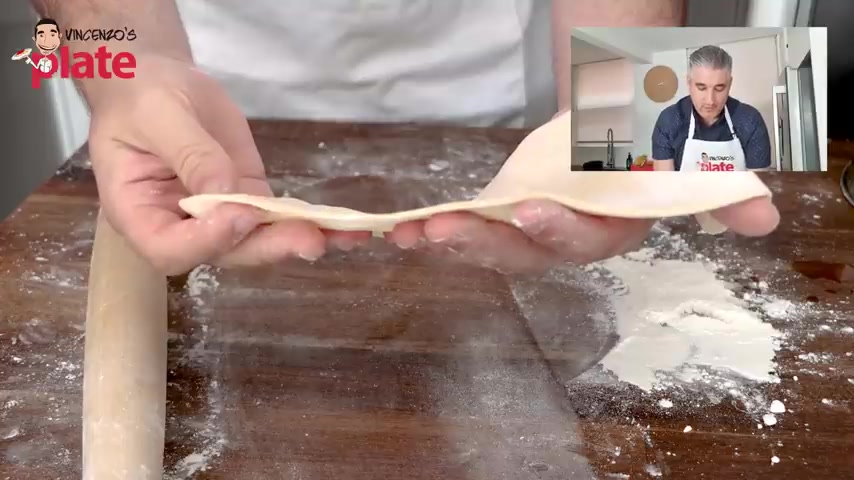
If you are making spaghetti , you do wanna make it thin as thin as possible if you're making lasagna shade .
Well , the lasagna sheet is kind of ready if you ask me because you want the lasagna to be kind of a little bit thick because it does cook for a long time .
And if you make it too thin , it will disappear in the sauce .
So this is ready for a lasagna .
In my opinion , we want to create shapes .
So what I'd like to do is this I fold in , then I fold in again , I fold in again here and then we cut it into the shape that we want .
And in this case , I'm going to make is like a bit thicker than spaghetti .
You can make your with this , see what I can do .
Now , if I want , I can make , which is thicker and like that .
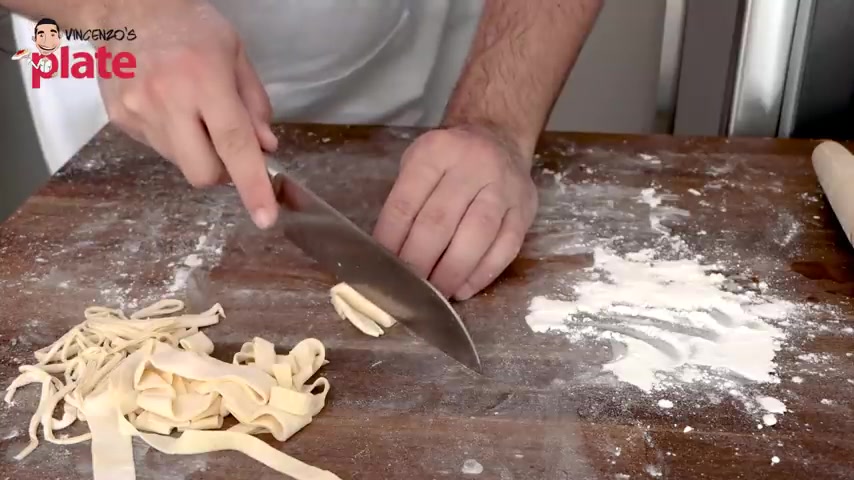
So I've got beautiful .
If I want to do , then I just make it a bit smaller than and here I have for you .
So now what else can you do ?
You can make it so thin .
You can do spaghetti .
If you want , you just need to make sure you use a good knife and here we can create spaghetti , egg spaghetti .
See how beautiful it is to make pasta .
So so simple .
I'm gonna do more videos how to make different types of pastas .
So now at this point that you have all this pasta , you do wanna put flour on top .
OK ?
Mix a mix the problem and make sure you cover your pasta .
The pasta always needs to be covered because if it dries up , it's not gonna be nice .
This is egg pasta and you don't wanna serve this dry .
Now , let's show you how to make it with the pasta machine to make it with the pasta machine .
Again , we cut a piece .
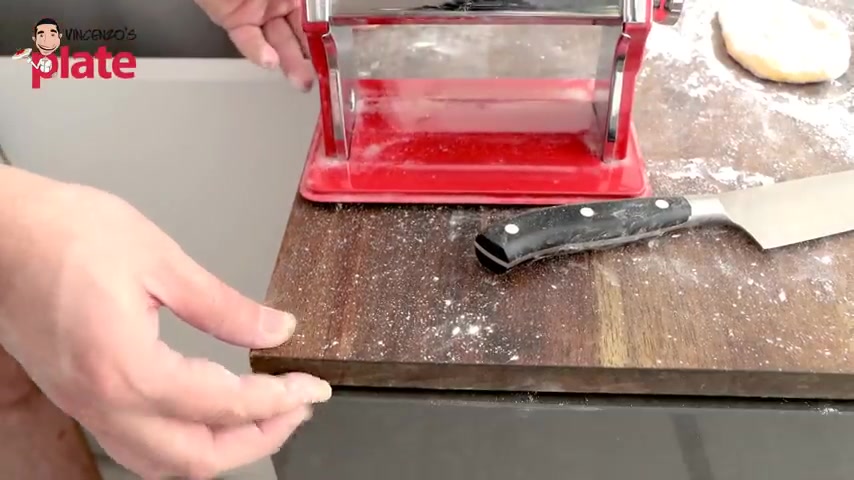
So I'm cutting this much and again , flour is your best friend .
So here are these two sides right now , they are sticky .
So what we wanna do , we wanna put flour there , flour there and press OK ?
Press just like this and then we wanna put it through the pasta machine .
OK ?
Guys , it's very easy to use a pasta machine .
So what you do is you get the pasta machine , use the party away with the hole .
And what we do is we put it there next to the edge of your board .
OK ?
Then we have this utensil this one that we want to put through the hole .
So all the way down , push inside and lock it in the other step that we have .
Now , we need to add this and this , we put it here .
OK ?
So this is what you need to create the pasta shapes .
And then we have this to rotate a pasta .

So the pasta machine has this , which we need to put on this uh wides setting starts from one , it goes all the way to nine .
So this is where we're gonna put the pasta sheet first to make it smooth to make it long .
And then this is what we can use to create pasta shapes .
So we have spaghetti or UC .
So now what you need to do , you need to make sure that you put flour everywhere here .
Because when we put the pasta through this , we don't want the pasta to get stuck in there .
OK ?
So when you put the pasta in you don't put the pasta in like this .
Otherwise it's gonna be very long and skinny .
We want this to be nice , wide and long enough .
You don't want the pasta to be extremely long .
So what we do is when you put it on number one , so the setting starts , starts from number one goes all the way to number nine .
OK .
So start from the wide setting and this is what we do pass it through , be gentle , don't rush .
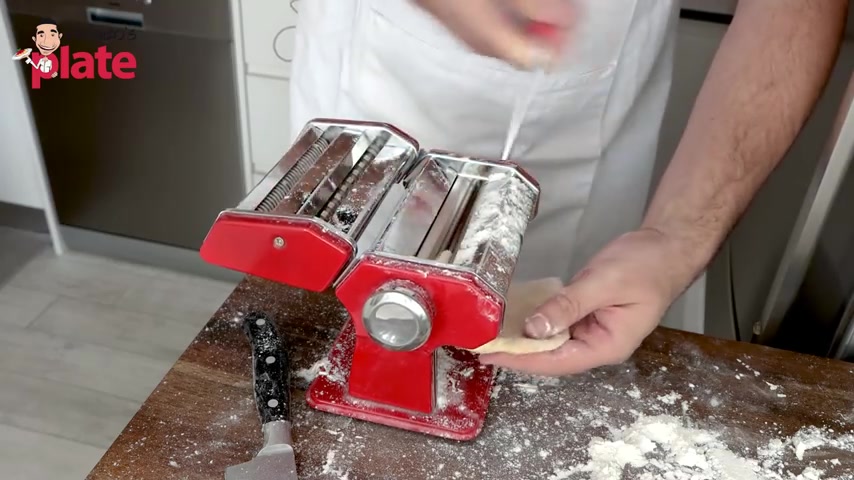
And at this point , what we do is we fold it again and we passed through a again the reason why we do this because we want to get rid of all the hair inside the door .
Look at that , see and have the dough .
We do one more time now without folding or number one .
OK ?
And we did the base .
That's the beginning .
OK ?
Now we can start stretching more .
So from number one , we go to number two .
So from number two , what is what we do ?
Look at that .
Look at how much it is stretching already .
Number two .
So it's becoming smoother .
The dough is beautiful , nice and yellow .
If you feel like your dough is a bit sticky , please feel free to pass it on the , on the flower and just put some flour on top only if you feel like it's sticky .
And I like to go the way to number seven , I believe number seven is the perfect size for a pass that we eat .
So do one more time .
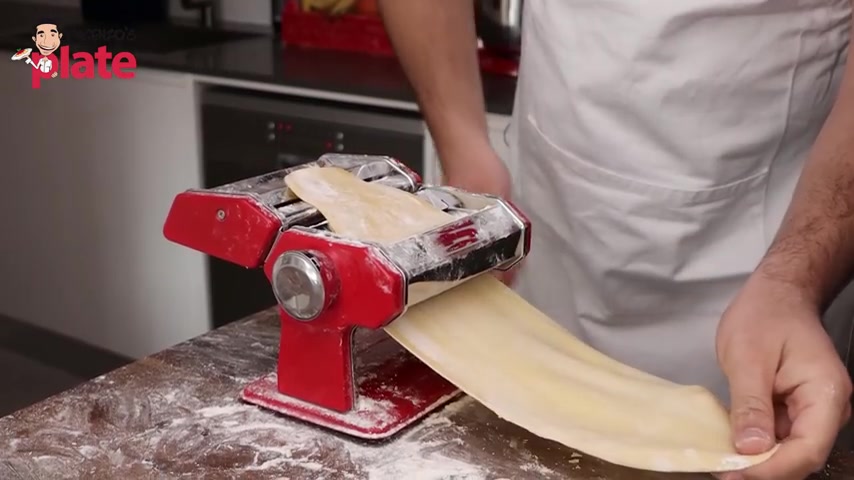
Number seven .
And we do the test .
If you can see your fingers through the pasta , then it's done .
It's ready .
So look how perfect it is .
The pasta machine is definitely easier , definitely more precise because when you do it by hand with the rolling pin , it's not precise , but look what we got here .
You can see my fingers and now we can make any pasta we want .
So let's just cut the pasta enough .
And again , we wanna put some uh flour on this .
Let's make we love .
So look what I'm doing .
Now , I move this to this .
We've got enough flour on the pasta because at this point , we don't want the pasta to get stuck .
So just pass it on the flour again , there's nothing wrong with doing that and look what I'm going to do right now .
Pasta is gonna come out on the other side and it's gonna be beautiful .
It's going to be perfect .
And this is how you make a beautiful , perfect pasta .
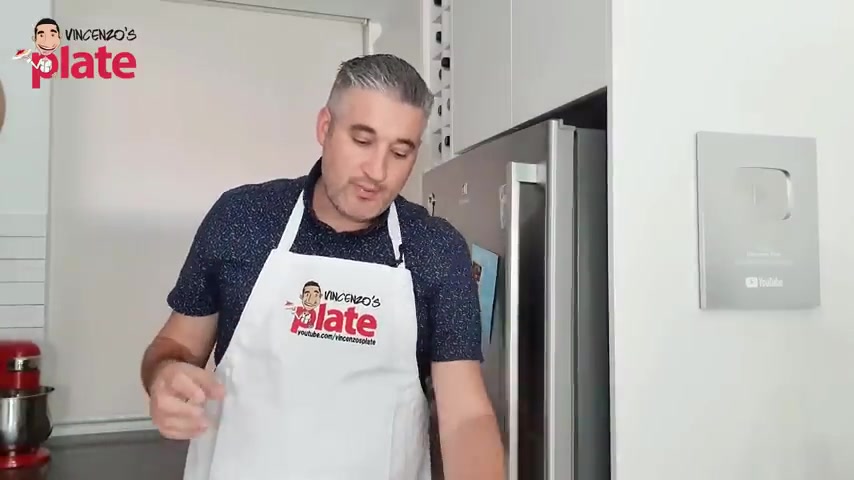
So here is the right length for the , what you need to remember is that when you cook your pasta , it needs to be fresh , you can freeze your pasta .
Yes .
What I love to do .
I get a tray .
I put them a pasta on top of the tray and I freeze it straight away .
So that way I've got a pasta any time I want pasta and you need , you should be making that portion just like this .
You can keep it in the fridge for one or two days when it's fresh .
After two days it starts to , it's not good anymore .
Get stuck together .
How beautiful this project is .
It's relaxing and it's nice for you .
You can do this for your family .
You can do it with love and that's on portion for you .
My friend , you can do , you can do a , you can do spaghetti , you can do anything .
When you freeze your pasta , you cook it straight from frozen .
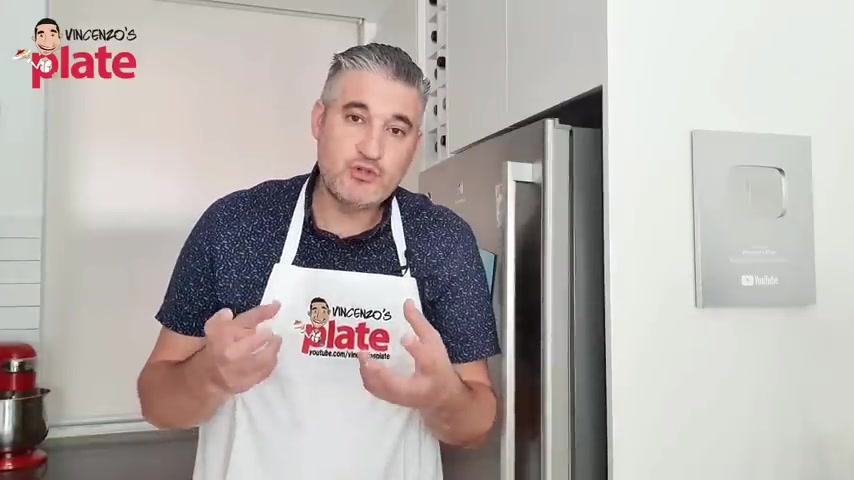
So what you need to remember is that you don't defrost the pasta because if you do defrost the pasta , then uh it's gonna be terrible , rubbery soggy .
It will get stuck together .
You cook straight from frozen into the boiling water .
That's it .
And you cook it for two extra minutes .
A pasta like this takes about three minutes to cook .
If you make a thicker pasta , maybe it takes 4 to 5 minutes .
Spaghetti , fresh spaghetti will take about two minutes .
But if you are going to freeze it , add two extra minutes and the rule is always taste it .
OK ?
Don't just follow the number because it's fresh .
So there is no packet telling you how long to cook it for .
You need to taste it , try it and make sure it's nice and for me it's really nice because I can have this raw .
Mm In the next video , I'm going to share your favorite pasta shape .
Be ready .
So thank you so much for watching this episode .
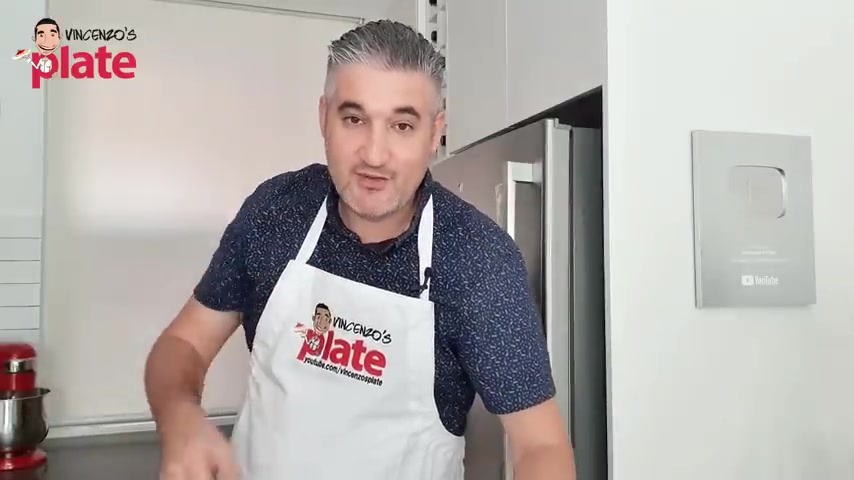
We will see you in the next Vincenzo plate with your recipe .
Vincenzo plate .
Plant your pasta .
Are you looking for a way to reach a wider audience and get more views on your videos?
Our innovative video to text transcribing service can help you do just that.
We provide accurate transcriptions of your videos along with visual content that will help you attract new viewers and keep them engaged. Plus, our data analytics and ad campaign tools can help you monetize your content and maximize your revenue.
Let's partner up and take your video content to the next level!
Contact us today to learn more.